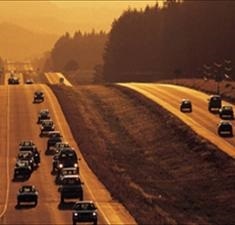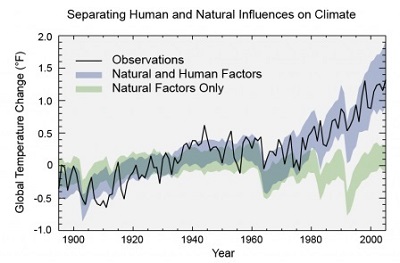|
|
| |
|
|
| |
|
|
| Scientific overview of climate change |
|
| |
 Overview of Climate Change Science Overview of Climate Change Science
Earth's climate is changing. Multiple lines of evidence show
changes in our weather, oceans, ecosystems, and more.
Natural causes alone cannot explain all of these changes.
Human activities are contributing to climate change,
primarily by releasing billions of tons of carbon dioxide
(CO2) and other heat-trapping gases, known as greenhouse
gases, into the atmosphere every year. |
 Climate
changes will continue into the future. The more greenhouse
gases we emit, the larger future climate changes will be. Climate
changes will continue into the future. The more greenhouse
gases we emit, the larger future climate changes will be.
Changes in the climate system affect our health,
environment, and economy. We can prepare for some of
the impacts of climate change to reduce their effects on our
well-being. |
|
 Earth's
climate is changing Earth's
climate is changing
The global average temperature has increased by more than
1.5°F since the late 1800s. Some regions of the world
have warmed by more than twice this amount. The buildup of
greenhouse gases in our atmosphere and the warming of the
planet are responsible for other changes, such as: |
- Changing temperature and
precipitation patterns
- Increases in ocean temperatures, sea
level, and acidity
- Melting of glaciers and sea ice
- Changes in the frequency, intensity,
and duration of extreme weather events
- Shifts in ecosystem characteristics,
like the length of the growing season, timing of flower
blooms, and migration of birds
- Increasing effects on human health
and well-being
|
 Picture
- These maps show temperatures across the world in the 1880s
(left) and the 1980s (right). Blue colors represent cooler
temperatures compared with the average temperatures from
1951 to 1980, and red colors represent warmer temperatures
compared to this average. The map on the left shows that it
was colder in the 1880s in most places. The map on the right
shows it was warmer in the 1980s in most places. Earth's
average surface temperature has increased by more than 1.5°F
since the 1880s. Two-thirds of the warming has occurred
since 1975, at a rate of roughly 0.3°F – 0.4°F per decade. Picture
- These maps show temperatures across the world in the 1880s
(left) and the 1980s (right). Blue colors represent cooler
temperatures compared with the average temperatures from
1951 to 1980, and red colors represent warmer temperatures
compared to this average. The map on the left shows that it
was colder in the 1880s in most places. The map on the right
shows it was warmer in the 1980s in most places. Earth's
average surface temperature has increased by more than 1.5°F
since the 1880s. Two-thirds of the warming has occurred
since 1975, at a rate of roughly 0.3°F – 0.4°F per decade. |
|
Natural causes alone cannot explain
recent changes
Natural processes such as changes in the sun's energy,
shifts in ocean currents, and others affect Earth's climate.
However, they do not explain the warming that we have
observed over the last half-century. |
 Human
causes can explain these changes Human
causes can explain these changes
Most of the warming of the past half century has been caused
by human emissions of greenhouse gases.
Picture - Models that
account only for the effects of natural processes are not
able to explain the warming observed over the past century.
Models that also account for the greenhouse gases emitted by
humans are able to explain this warming.
Greenhouse gases come from a variety of human activities,
including: burning fossil fuels for heat and energy,
clearing forests, fertilizing crops, storing waste in
landfills, raising livestock, and producing some kinds of
industrial products.
Greenhouse gas emissions are not the only way that people
can change the climate. Activities such as agriculture or
road construction can change the reflectivity of Earth's
surface, leading to local warming or cooling. This effect is
observed in urban centers, which are often warmer than
surrounding, less populated areas. Emissions of small
particles, known as aerosols, into the air can also lead to
reflection or absorption of the sun's energy. |
|
 The
extent of future climate change depends on us The
extent of future climate change depends on us
The extent of the change will depend on how much, and how
quickly, we can reduce greenhouse gas emissions.
Picture - This graph
shows the increase in greenhouse gas (GHG) concentrations in
the atmosphere over the last 2,000 years. Increases in
concentrations of these gases since 1750 are due to human
activities in the industrial era. Concentration units are
parts per million (ppm) or parts per billion (ppb),
indicating the number of molecules of the greenhouse gas per
million or billion molecules of air.
During the 21st century, global warming is projected to
continue and climate changes are likely to intensify.
Scientists have used climate models to project different
aspects of future climate, including temperature,
precipitation, snow and ice, ocean level, and ocean acidity.
Depending on future emissions of greenhouse gases and how
the climate responds, average global temperatures are
projected to increase worldwide by 0.5°F to 8.6°F by 2100,
with a likely increase of at least 2.0°F for all scenarios
except the one representing the most aggressive mitigation
of greenhouse gas emissions. |
|
|
Climate change impacts our health,
environment, and economy
Climate change affects our environment and natural
resources, and impacts our way of life in many ways. For
example: |
- Warmer temperatures increase the
frequency, intensity, and duration of heat waves, which
can pose health risks, particularly for young children
and the elderly.
- Climate change can also impact human
health by worsening air and water quality, increasing
the spread of certain diseases, and altering the
frequency or intensity of extreme weather events.
- Rising sea levels threaten coastal
communities and ecosystems.
- Changes in the patterns and amount
of rainfall, as well as changes in the timing and amount
of stream flow, can affect water supplies and water
quality and the production of hydroelectricity.
- Changing ecosystems influence
geographic ranges of many plant and animal species and
the timing of their lifecycle events, such as migration
and reproduction.
- Increases in the frequency and
intensity of extreme weather events, such as heat waves,
droughts, and floods, can increase losses to property,
cause costly disruptions to society, and reduce the
availability and affordability of insurance.
|
|
We can prepare for some of the likely climate change impacts
to reduce their effect on ecosystems and human well-being.
Making such preparations is known as adaptation. Examples of
adaptation include strengthening water conservation
programs, upgrading storm water systems, developing early
warning systems for extreme heat events, and preparing for
stronger storms through better emergency preparation and
response strategies. |
|
|
|
|
|
|
|
|
|
|
|
|
Additional Climate Change Information |
Climate Change and Carbon Dioxide
(Beginner - Listening,
reading)
A video lesson to
help with your understanding of climate change
and carbon dioxide.
The English is
spoken at 75% of normal speed.
Great English listening and reading practice. |
Carbon Dioxide and Climate Change
(Beginner - Listening,
reading)
A video lesson to
help with your understanding of carbon dioxide
and climate change.
The English is
spoken at 75% of normal speed.
Great English listening and reading practice. |
Environmental Group Warns Earth's Health at Risk
(Beginner - Listening,
reading)
A video lesson to
help with your understanding of climate change.
The English is
spoken at 75% of normal speed.
Great English listening and reading practice.
A report by the World Wildlife Fund looked at thousands of animal populations
and found they have dropped significantly in 40 years. |
Sea Levels Rising at Fastest Rate in 3,000 years
(Beginner - Listening,
reading)
A video lesson to
help with your understanding of climate change.
The English is
spoken at 75% of normal speed.
Great English listening and reading practice.
A group of scientists say sea levels are rising at record rates. Another group
found that January temperatures in the Arctic reached a record high. |
Capturing CO2 Gas Is Not Easy
(Beginner - Listening,
reading)
A video lesson to
help with your understanding of climate change.
The English is
spoken at 75% of normal speed.
Great English listening and reading practice.
Most scientists agree that carbon-dioxide gas is partly to blame for climate
change: rising global temperatures. But capturing the CO2 gas released by power
stations is costly and difficult. |
Growth, Climate Change Threaten African Plants and
Animals
(Beginner - Listening,
reading)
A video lesson to
help with your understanding of climate change.
The English is
spoken at 75% of normal speed.
Great English listening and reading practice.
Researchers believe Africa may lose as much as 30 percent of its animal and
plant species by the end of this century. |
|
|
|
|
Search Fun Easy English |
|
|
|
|
|
|
|
|
|
|
|
|
|
|
|
About
Contact
Copyright
Resources
Site Map |